-
Sand Making Crusher
- PCL-Vertical Shaft Impact Crusher
- SBM Hydraulic VSI Crusher
- VSI5X Series Impact Crusher
Calcium carbonates beneficiation

Calcium carbonate (calcite) is found in limestone rock along with various mineral impurities, particularly silicates such as, quartz, mica, feldspar, etc. The most common known methods for separating the calcite from the mineral impurities involve physical separations whereby the limestone rock is first ground and slurried and the ground material is subject to flotation by employing some means which selectively imparts hydrophobicity to certain of the components of the rock to enable such components to be floated away. In the reverse flotation process it is the impurities which are floated away from the calcite. Documents download
We provide stone crusher,Grinding mill for calcium carbonates beneficiation.and we can provide Spiral classifier, Flotation separator, Wet concentrator, Filter press, Dryer, ect. If you need any calcium carbonates beneficiation machines, please contact us.
The most important criteria in evaluating the performance of a calcium carbonate ore collector are: (1) effective dosage level required;
(2) Yield, which is defined as the percent of calcium carbonate which does not float away during the reverse flotation; and
(3) Acid Insoluble, a measurement of silicate impurities in the beneficiated ore (the percent of the calcium carbonate product which remains following reaction with hydrochloric acid). Commercial goals for such criteria are a dosage level of from about 0.1 to about 0.5 pounds of collector per ton of ore, a Yield at least about 90% and an Acid Insoluble of less than about 0.5%. Of course, as discussed above, other considerations such as whether the collector comprises a single liquid system, its effect on product properties and its comparative cost can also be very important.
- Limestone Crusher
- Barite Crusher
- Granite Crusher
- Kaolinite Crusher
- Calcite Crushing
- Tombarthite Crusher Mill
- Bentonite Grinding Plant
- Basalt Ore Crusher
- Lignite Crusher Mill
- Silica Ore Crusher
- Tin Ore Mine
- Lead and Zinc Ore Crusher
- Ochre Crusher Mill
- Garnet Crusher
- Mica Crusher
- Asbestos Crusher
- Manganese Ore Crusher
- Talc Crusher Mill
- Feldspar Crusher
- Iron Ores Crusher
- Dolomite Crusher
- Quartz Crusher
- Gypsum Crusher
- Calcium Carbonate Grinding
- Calcium carbonate mining
- Calcium carbonate pulverizer
- Calcium carbonate beneficiation
- Calcium carbonate process
- Calcium carbonate crushing
- Calcium carbonate quarry
- About Us
- |
- Service
- |
- News & Events
- |
- Contact Us
- |
- Resources
- |
- Showroom
Aggregate Crusher
Artificial Sand Making
Ballast Crushing Machine
Basalt Stone Crusher
Barite Mine Process
Beneficiation Plant
Bentonite Crusher
Bentonite Milling
Calcium Carbonate Crusher
Calcium Carbonate Grinding
Cement Grinding
Concrete Crusher
Coal Crusher
Copper Crusher
Cement Mill
Chrome Mining Process
Copper ore Beneficiation
Coal Processing
Coal Pulvarizer
Feldspar Crushing
Feldspar Grinding
Flotation Machine
Gold Crusher
Gold Mine Equipment
Gold Processing Machinery
Granite Crusher
Granite Crushing Machine
Granite Quarry Equipment
Gypsum Crusher
Gypsum Mining
Gypsum Powder Production
Iron Ore Beneficiation
Iron Ore Crusher
Kaolin Processing Plant
Limestone Crusher
Silica Sand Crusher
Iron Ore Mining Equipment
Cement Production Line
Talc Production Line
Quartz Crushing Machine
Limestone Mining Process
Manganese Benificietion
























